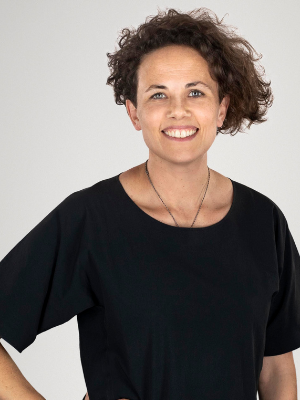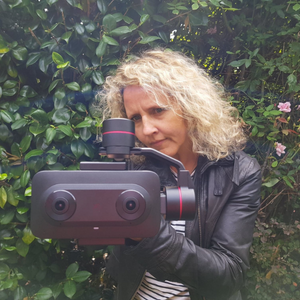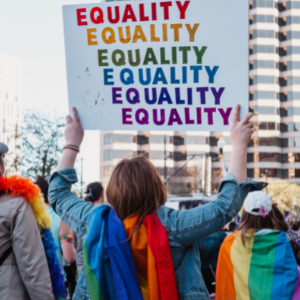Caroline Samponaro: Head of Transit & Micromobility Policy, Lyft
 “One thing I learned through my community organizing training with Midwest Academy is this idea of leadership: that giving power away is how you grow a powerful movement,” says Caroline Samponaro. “I focus on imparting that message to those I manage: how are we giving away power to build a strength of team and community that can be that much more successful?”
“One thing I learned through my community organizing training with Midwest Academy is this idea of leadership: that giving power away is how you grow a powerful movement,” says Caroline Samponaro. “I focus on imparting that message to those I manage: how are we giving away power to build a strength of team and community that can be that much more successful?”
Samponaro speaks to how social issues led her to transport and the journey to feeling confident in her voice.
Social Issues Led Her to Transit
An epic bike ride through Japan is what first set Samponaro, an anthropology major at Colombia University at the time, on the unexpected trajectory of working in transportation.
While writing a thesis on the topic of bike activism, she then began to ride around New York City. She discovered an intriguing intersection between social issues and transport. While working as a paralegal, she started to participate in monthly Critical Mass bike rides on Fridays, an action to create safety in numbers for cyclists by reclaiming the streets.
After challenging an arrest while on a bicycle, she co-founded a group, with other law students and lawyers, called The FreeWheels Bicycle Defense Fund, that raised funds and provided legal support to help cyclists challenge their charges.
“I didn’t come into transportation from a planning or policy perspective initially,” says Samponaro. “I was intrigued about the way that it was an intersection point into cities and government and social issues.”
Though she gained entry into law school, she instead began in a working in transportation in a non-for-profit and never looked back. After twelve years at Transportation Alternatives across various advocacy roles, feeling her impact was limited in scale, she decided to move to the private sector with Lyft as the company expanded its scope to include micromobility.
Affecting Inclusion through Transport
Transportation is a pervasive industry because it touches most people on a daily basis, and Samponaro’s work is disrupting the norms we take for granted that weren’t always norms.
“In the U.S., we’ve spent more than a century building the private automobile into everyday life,” notes Samponaro. “There are New York Times articles from the introduction of the automobile era which reflect the public’s uproar over the invasion of these automobiles onto the streets, which traditionally had been used as gathering places, stickball locations, parks, food markets and all the things.”
“We also heavily subsidize single-occupancy vehicle trips to mask the massive toll this form of transportation takes on society – free parking, cheap gas, roads designed entirely for vehicular traffic. It’s not surprising that roughly 77% of Americans drive alone in their car to work. As we face big challenges like climate change, housing, and equitable access to transportation options, removing the single occupancy vehicle from day to day life is part of getting at the root of the problem,” she says. “Lyft as a company is challenging the premise of the single occupancy vehicle through rideshare, our large-scale bikeshare programs and the ways that we provide our customers with trip planning to integrate transit into a daily commute.”
Samponaro’s line of work in micromobility is focused on creating a network of shared bicycles and scooters that functions like a public transportation system. Though bike activism originally drew her into urban biking, she feels her work is helping to remove the identity politics from riding a bike, while overcoming some of the disadvantages of not owning a car.
“At the end of the day, if we’re trying to transform the way people get around, and make it more equitable and safe, it’s important that when people choose to get on a bike to go to work, they’re not making an identity decision,” she notes. “They’re making a practical one, with a tool that is available, easy and affordable.”
Bringing A More Diverse Human Element to Transit
“In the context of biking and micromobility, often the market is orientating itself towards the perspective of a young white male,” Samponaro observes. “I’ve tried to find opportunities, whether through my own perspective or bringing in the perspective of other women, to make sure we’re inserting a broader view into how we plan our programs and welcome people to our systems.”
For example, street designs generally make the thought of shifting to a bicycle both scary and implausible: “You have to be daring, and you shouldn’t have to be thinking about whether you’re risking your life in your transportation choice. That’s not logical, so I think that impacting the systems around people’s choices become the ways you ensure equity and access.”
“It’s important that there are engineers building models and algorithms to make non-driving easier and more attainable,” notes Samponaro. “I’m most excited about my work when I’m bringing the human dimension to that essential product development. Given how much this area impacts the lives of people, having a people-centric perspective on the work of transportation has been an asset that I can bring and that I find great satisfaction in.”
A Culture of Belonging
“Growing up, I just passed as someone that people assumed was straight. So I struggled mostly in the context of work with a feeling of being closeted, unless I chose not to be,” says Samponaro. “Always coming out over and over again has its own challenges.”
Working in a highly male-dominated industry, she has often been the only woman or one of few women at the table. As a married lesbian mother of 4.5 year old twins, the years have brought internal and contextual changes that have helped her feel confident in embodying her own voice.
“Getting to a place of success and building my career trajectory involved feeling bad about myself at times and being slightly insecure that it wasn’t going to go my way, whether it was the raise or the promotion,” she notes. “If I spoke too loudly in the meeting, was I going to be called out for being rude, as opposed to be appreciated for being assertive? As I became more senior, the biggest feedback I received was that I was not being considerate enough in my tone, the kind of feedback that I feel men don’t receive. So the context of being queer just layered on top of those feelings of insecurity and asking if I belonged.”
Samponaro notes that achieving successes is different than having an inherent feeling of ease and belonging: “The overwhelming sense I used to have was as hard as I was trying and as good as I was doing,” she recalls, “I wasn’t going to get asked to that drink or get added to that bike ride or get included.”
Samponaro accredits much of the belonging and encouragement she now feels to being in an environment where there is a dedicated emphasis on building an equitable company culture.
“I have personally grown to a place where I could feel belonging, but then Lyft is just a wonderful place to work in terms of the emphasis it places on creating affinity groups, recognizing people’s differences, celebrating them and creating opportunities for that to be happening all the time,” she observes. “There’s so much structure built around ensuring that the company is doing equitability, right. The intentionality is key.“
Now that she feels more confident in her voice, Samponaro seeks to become the ally that she realizes she may not have dared to be: “ln my attempts to make sure I kept my job and kept growing in the way I wanted to, did I do enough speaking out on behalf of others around me? Did I do enough ally work? I think the answer, probably up until recently, is ‘no.’”
Samponaro is recognized by those who mentor her for her focus and determination to create change through the work she does. She has learned to embrace her sensitivity and capacity for empathy, though at times challenging, as an asset which has enabled her to truly impact the communities she serves.
By Aimee Hansen










